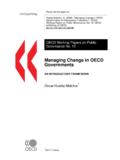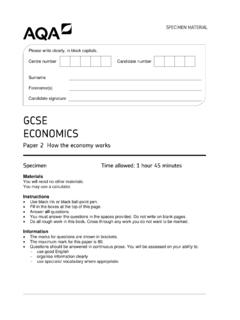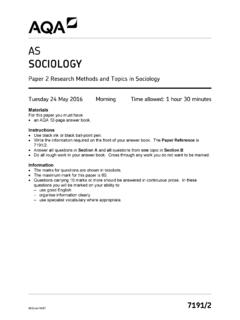Transcription of Compressed Air Engineering - Kaeser
1 Air EngineeringBasic principles, tips and suggestions32 Dear reader,More than two thousand years ago, Socrates, the famous Greek philosopher, succinctly said: There is only one good, knowledge, and one evil, ignorance. These ancient words of wisdom from one of the founding fathers of Western civilisation apply today more than ever, since nothing seems more permanent than change. The ever-increasing scope and speed of change brought about by technological evolution and economic globalisation demand new answers and new strategies. Now, more than ever, challenges should be seen as opportunities to achieve even greater success in the future and should therefore be adopted and utilised to their full potential.
2 Our increasingly networked and complex world is transforming knowledge into becoming the most valuable raw material of the future. Due to the exponential growth of this commodity, it is only those with a strong commitment to education and continued training who will reap the true rewards. In the world of Compressed air Engineering , for example, merely having the knowledge of how to construct powerful compressors, and install and operate them correctly, is not enough and hasn t been for some who wish to take full advantage of what com-pressed air, as an energy carrier, has to offer must consider the entire Compressed air system as a whole.
3 Moreover, they should have a detailed understanding of the numerous interactions and infl uences that occur within the system, as well as how it integrates into the operating environment. Kaeser KOMPRESSOREN is therefore dedicated to the further training of its customers and achieves this in a number of ways. For example, qualifi ed technical experts with extensive practical experience travel around the world every year, making stops on every continent to speak at conferences, information events and seminars about effi cient Compressed air production and usage. Of course, this is in addition to the many technical publications across a broad range of media.
4 In this brochure you ll fi nd an executive summary of our experts extensive knowledge. Following an in-depth yet highly accessible introduction to the fi eld of Compressed air technology, you ll fi nd a series of practical tips for system operators and Compressed air users. You will also recognise a common theme throughout: in so many cases and in so many different ways, even small changes in the Compressed air system result in signifi cant and tangible improvements in the effi ciency and availability of this key energy carrier. ContentsForewordFundamentals of Compressed air cient Compressed air do we need to dry Compressed air?..Condensate: Correct : Safe, economical cient compressor compressor performance to meet actual savings with heat and installing a new Compressed air distribution an existing air distribution air demand analysis (ADA) Determining the current the most effi cient cient compressor station long-term reliability and 4 6 81012141820222426303234 Savings with optimised pressure at the air cient Compressed air in the Compressed air compressor air station ventilation (intake).
5 Compressed air station ventilation (exhaust)..FundamentalsPractical tipsAppendices404244464849505052 Chapter 1 Chapter 2 Chapter 3 Chapter 4 Chapter 5 Chapter 6 Chapter 7 Chapter 8 Chapter 9 Chapter 10 Chapter 11 Chapter 12 Chapter 13 Chapter 14 Tip 1 Tip 2 Tip 3 Tip 4 Tip 5 Tip 6 Tip 7 Appendix 1 Appendix 2 Nomograph Determining pipe examples regarding the Energy Saving System Thomas Tina-Maria V2 x P2 x T1V1 = [p1 (pD x Frel)] x T2 Electrical power consumptionPspec. = DeliveryEffi ciency (%)Output (kW)Range of application according to EU DirectiveValues for 4-pole motors, 50 HzIE4IE3IE2IE1 to 1,000 Fig.
6 3: The IEC standard the new efficiency classification of electric motors. Beginning with 1 January 2015, IE3 motors are mandatory in the EU. Meanwhile, a further improved motor efficiency class IE 4 has been s the same with Compressed air as with many other things in life: a small cause can have a large effect both in a positive and negative sense. Upon closer inspection things are often different from how they at fi rst appear. In unfavourable conditions Compressed air can be expensive, but in the right circumstances it is very economical. In this fi rst chapter we will explain the terms used in Compressed air Engineering and the things you should watch for in con-nection with Free air deliveryThe air delivery of a compressor (known also as the free air delivery or FAD) is the expanded volume of air it forces into the air main (network) over a given period of time.
7 The correct method of measuring this volume is given in the following standards: DIN 1945, Part 1, Annex F and ISO 1217, Annex C. The measurement process is performed as follows as shown in Fig. 1: the tem-perature, atmospheric pressure and humidity must fi rst be measured at the air inlet of the compressor package. Then, the maximum working pressure, temperature and volume of Compressed air discharged from the compressor are measured. Finally, the volume V2 meas-ured at the compressor outlet is referred back to the inlet conditions using the shown equation (see formula). The result is the free air delivery (FAD) of the compressor package.
8 This fi gure is not to be confused with the airend delivery (block delivery).Note:DIN 1945 and ISO 1217 alone only defi ne the airend delivery. 2. Motor shaft powerThe motor shaft power is the power that the motor delivers mechanically to its output shaft. The optimal value for motor shaft power is the point at which optimum electrical energy effi ciency is achieved and the cos power factor is reached without the motor overloading. This fi gure lies within the range of the rated motor power. The rated power is shown on the motor s nameplate. Note: If the motor shaft power devi-ates too far from the rated motor power, the compressor will run inef-fi ciently and/or will be subject to increased Electrical power consumption The electric power consumption is the power that the drive motor draws from the mains power supply with a defi ned mechanical load on its shaft (motor shaft power).
9 The power consumption exceeds the motor shaft power by the value of the motor losses both elec-trical and mechanical from bearings, fan, etc. The ideal electric power con-sumption P can be calculated using the formula:Un, ln, and cos nare quoted on themotor Specifi c powerThe specifi c power of a compressor (Fig. 2) is the relationship between the electric power consumed and the Compressed air delivered at a given working pressure. The electrical power consumption is the sum of the power consumed by all consumers in a com-pressor, for example, drive motor, fan, oil pump, auxiliary heating, etc.
10 If the specifi c power is needed for an economic appraisal, it should refer to the compressor package as a whole and the maximum working pressure. The overall electrical power consumption at maximum pressure is then divided by the FAD at maximum pressure:5. IE The new formula for energy-saving drives Efforts in the USA to reduce the energy requirements of three-phase asynchro-nous motors resulted in the Energy Policy Act (EPACT) becoming law in 1997. A short while later, an effi ciency classifi cation system was also intro-duced in Europe. The international IEC standard for electric motors has been in place since 2010.





